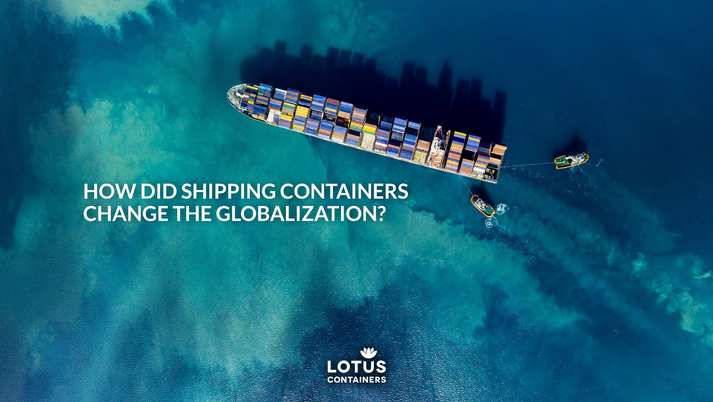Earlier it was impossible even to think about moving cargo to distant places. But today, most of the things we see around us have been shipped in maritime containers. This innovative invention by Malcolm McLean changed the pattern of cargo transportation and boosted the supply chain. McLean, along with Keith Tantlinger, came up with intermodal containers. With this invention, moving things around the globe became an easy task. It would not be wrong to say containers are catalysts for globalization. This answers the question, “How did shipping containers change globalization?” The cargo containers contribute a great deal to facilitating global trade. By making world trade easier, the units helped globalization and brought a massive change.
During the war with Vietnam, the USA needed to send ammunition and supply to Vietnam, and McLean’s idea was perfect for transferring goods. This gave way to the term containerization in the mid-twentieth century. Its impact on the global supply chain was humongous. The ships’ design, the functioning of ports, and docks all underwent a major change to accommodate steel shipping containers. The standard shipping unit size was 20ft shipping containers and 40ft shipping containers as described by the International Organization of Standardization (ISO). The organization set the units as standard sizes. The ship’s design needed to be changed to accommodate the ubiquitous boxes on the ship. As earlier, the ship’s design was entirely different. The whole fleet was changed as now the vessel would have to accommodate more than 1000 containers. The cargoes can fit in a shipping container now. The docks or ports’ size also increased as the large cargo units needed to be accommodated there.
Adapting containerization was challenging and gave the whole shipping industry a hard time. The old docks and ports moved from the traditional locations, i.e., the heart of cities and old docksides, to greenfield sites.
Post World War II, metal shipping containers ruled world trade. The ISO recommendations in the late 1960s made way for the cargoes to travel through intermodal transportation, i.e., the units can travel from a ship to train to truck. This brought about a revolution and decreased the break bulk cargo system. Break bulk cargo system is where every good was stuffed in the vessel separately, which was quite a labor-intensive process. It demanded a lot of manual power in packing and unpacking the goods and was also a costly affair. The earlier loading hours were reduced, and this containerization benefited exporters, importers, and consumers.
The global supply chain and world trade were at their high due to containerization. The shipping containers changed the supply chain and allowed businesses to flourish worldwide.
Freight containers are prevalent everywhere and have even entered the architectural market. The people have started converting the cargo units into shipping container homes, restaurants, offices, personal spaces, and whatnot.
There are specific ways in which we can pinpoint the ways containers impacted globalization. They are:
Changed maritime infrastructure
The metal freight container’s arrival drastically changed the portal infrastructure by developing ports. The old ports and docks were altered to accommodate the large maritime shipping containers. The ICD, CFS, and AFS (Inland container depot, Container freight station, and air freight station) emerged to help in better port and container management and functioning. The container depots came into the scene to safely store the freight boxes.
Machines taking over
The machines have taken over after break bulk has decreased. The cranes, forklifts, and other mechanisms have evolved, saving extra labor and costs. Machines can easily do the packing and unpacking.
Huge capacity and capital
As per Wikipedia, the largest container ships can accommodate up to 24,000 TEU. The containers can feasibly carry perishable and non-perishable cargo from electronic equipment and clothing to frozen foods, pharmaceuticals, etc. More than 90% of merchandise moves in freight units worldwide. This transportation increases the overall capita income of world trade and contributes significantly to the world economy.
Cost savings
The loading cost in 1956 was $5.86 per tonne. Labor, loading and unloading time, merchandise loss because of theft, and other damages account for approximately 75%. The freight transportation cost reduction came down to $0.16 per tonne.
Lesser time to market
Now the time for goods to reach the market has reduced. Earlier, either transportation was nearly impossible, or the cost was too high. Due to the increased loading and unloading time, and with high-speed ships and other transportation modes like trains, trucks, and aeroplanes, the cargo reaches the market in less time and enhances customer satisfaction.
Synchronization of global supply chain
The whole global supply chain is in synchronization and has become highly advanced. The automation in the maritime industry today made the containers trackable. The cargo boxes today have a GPS installed. Thus, it is easy to track the cargo.
Reduced emissions
The International Maritime Regulation has come up with many regulations to keep the emissions at bay by introducing green and biofuel. Thus, containers can move around the world more sustainably.
Thus, we know how did shipping containers change globalization! The shipping container changed the face of globalization and boosted the whole supply chain by providing answers to supply chain disruptions.
LOTUS Containers is one of the leading shipping container trading companies that offer shipping containers in Cincinnati, Ohio, Miami, and other parts of the USA and the world. We provide containers of all types and dimensions to help you with business needs.




